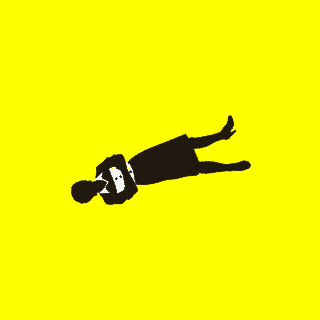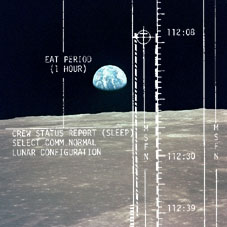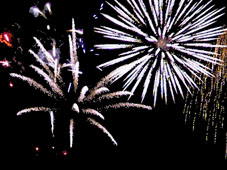Also the second of, for the time being, six sequels spread throughout the year
2004, "der nase nach" combines text and music in addition as well as irritation
to eachother. Where the observer discovers the texture of a plot, the music
increases latent sonic actions. The parallels meet on the radio.
Music & Bruitage: Josef Klammer
Text: Albert Pall
In the radiophonic work "The Disclassified File of Apollo 11", Oriol Graus,
Spanish composer and radio artist, unfolds an exciting story around the first
moon-landing on July 20th, 1969. The race between the USA and, at that time,
the Soviet Union concerning space flight had already begun in the late 50s.
In July 1969, the USA stood shortly before a pioneering success: The Apollo
11, and on board the astronauts Neil Armstrong, Michael Collins and Edwin
"Buzz" Aldrin, were approaching the moon-landing when, suddenly, interferences
were reported ... In the radio piece presented tonight, sound documents from
the so-called "A-XI" file - so far kept top secret - are unvailed; the surprised
expression in the voices of the ground engineers as well as the astronauts'
anxious reactions documentate the unexpected incident.
About the story:
The dream started vanishing when on October 4th, 1957 the artificial satellite
"Sputnik", was launched to space. Since then, more terrestrial spacecrafts
have been sent, giving us constant information from diverse parts of the universe.
On April 12th, 1961, the rocket "Vostok I" blasted off from the
Baiknour cosmodrome in the old Soviet Union, elevating into space the first
human being, Yuri Gagarin, orbiting around the earth. On May 25th, 1961, President
John F. Kennedy in his extraordinary speech before the USA Congress, proposed
to send a man to the moon in the 60s. On July 16th, 1969 "Apollo 11"
blasted off, ready to accomplish the mission; after orbiting twice around
the earth, it started its journey into space. Four days later, while the spacecraft
orbited around the moon to prepare the moon-landing, some interferences occured.
At first, the centre of operations in Houston was not aware of this fact that
was the result of one of the most extraordinary events ever known concerning
time-space and was documented in a top secret file called "A-XI File".
Today, for the first time we shall hear the disclassified sound documents,
which show the events that surprised the flight engineers and frightened the
astronauts. Finally, Neil Armstrong set foot on the surface of the moon for
the first time in human history on July 20th, 1969.
Produced by Radio Nacional de Espana; the piece was made available as
a "listening proposal" to members of the Ars Acustica group of the EBU.
An excerpt from Rainer Römer's "Seven Seconds" gives an atmospheric-acoustically
dense impression of a New Year's Eve. The source remains unedited whilst it
is structured by means of musical mini samples.
Just as Oriol Graus' piece, "Seven Seconds" is a so-called "Listening Proposal"
and was recommended for airing by the Ars Acustica group of the EBU.
Rainer Römer comments the idea and compository structure of the piece
as follows:
"Music is motion in time. And so I asked myself what happens when I react
to a pure, sonicly set continuum. The starting point of this piece is a 50
minute recording of a so-called turning point in time, the audible atmosphere
of New Year's Eve 94/95 made from around 11.50 p.m. to 0.40 a.m. on the windowsill
at my Frankfurt apartment. The recording as it is – unedited – develops an
unfolds gradiently; I structured it using different modules:
- improvisations on the table guitar, an instrument invented by Fred Frith
which resembles a "six string monochord" and offers a unique combination of
chords, linear tone sequels, and rhythmic articulation;
- the unedited chime of bells from the atmo tape that sounds like a technical
loop;
- an orchestra sample with slightly varied entries (from Puccini's "Madame
Butterfly");
- the roll of drums from the end of Verdi's "Requiem";
- a recording of somebody playing the piano, following the scale and playing
with sequels which could become a melody;
- as a coda, the sound of a tram squeaking around a bend.
A further structural element are three samples where passer-bys – a man,
a woman, children - give their idea of how to represent 7 seconds. Time is
counting and the prime number 7 has something mysterious about it, just as
3 does. It has a significance for music as well as for culture and for religion.
But actually it's insignificant, nothing but a number. And just as the atmosphere
is the solist here, my additions, my accompaniments my be nothing more than
an attempt to create a contemplative experience of time."
Produced by the Hessische Rundfunk; the piece was made available as a
"listening proposal" to members of the Ars Acustica group of the EBU.



